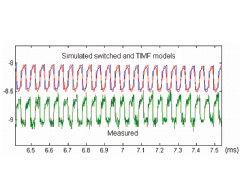Dynamic modeling of multiple-input power converters
Yongxiang Chen with adviser Patrick L. Chapman
Energy is supplied to systems with multiple energy sources through multiple-input power converters. A solar vehicle powered by a solar panel and a battery, for example, can use a two-input dc-dc converter controlled to simultaneously provide maximum power point tracking of the solar panel and steady output power to the motor.
Traditionally the design and analysis of a multiple-input power converter uses either switched or average-value models. The switched model provides more detailed and accurate results but requires significant computational effort. The averaged-value model is easier to compute, but accuracy is reduced and most switching details are omitted. In this study, a multi-frequency dynamic model is developed. It allows the user to trade off accuracy and computational effort and thus benefits the design process as well as overall system analysis.
The newly proposed model was simulated using the multi-frequency dynamic model and then compared against experimental results. The accuracy of the model was confirmed. Figure 24 shows a close-up of output voltages in steady state. Simulated switched and time-variant multifrequency models (TIMF) are shown in red and blue. The measured model is green. A linearized version was also developed for controller designs.
